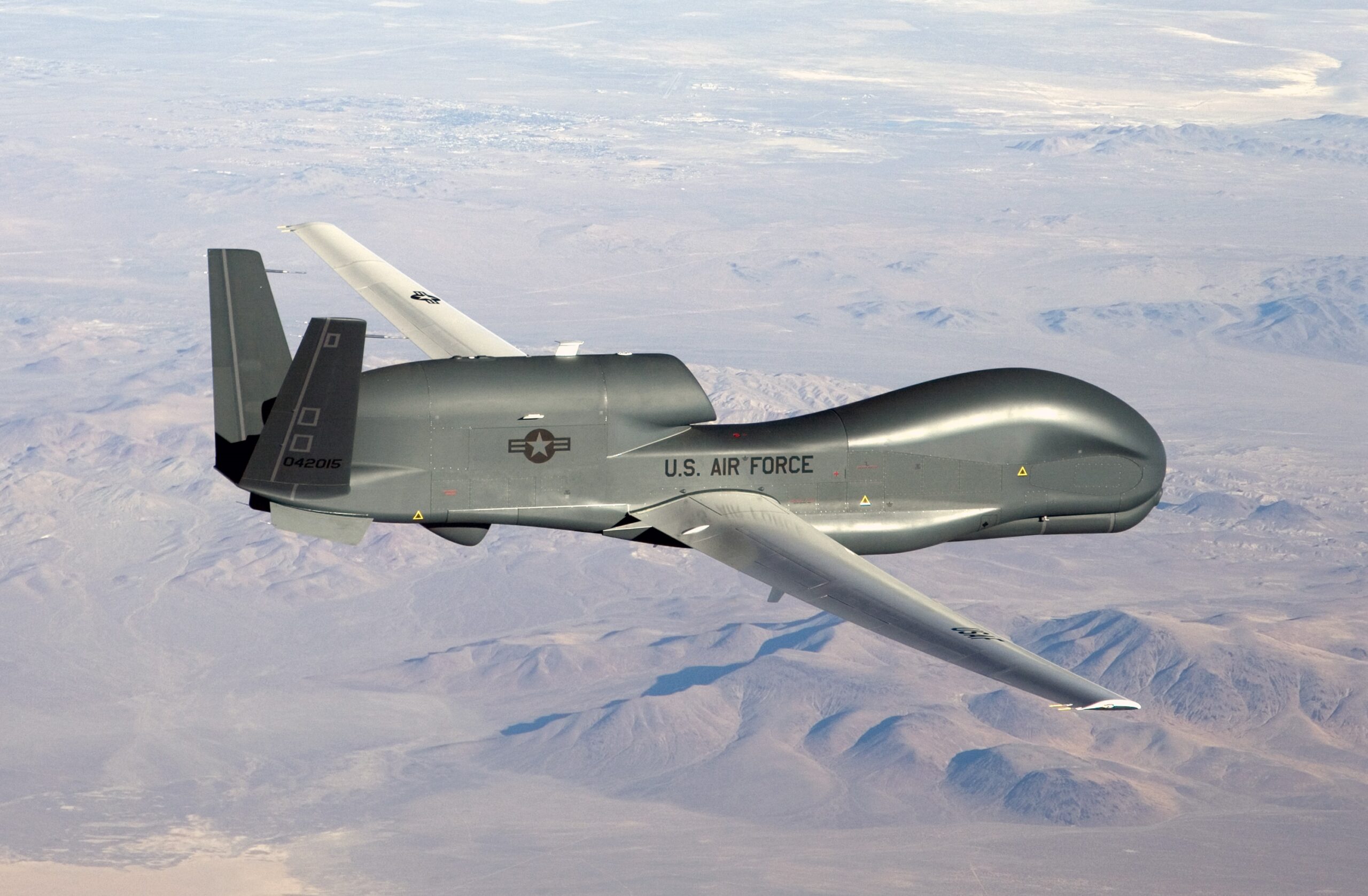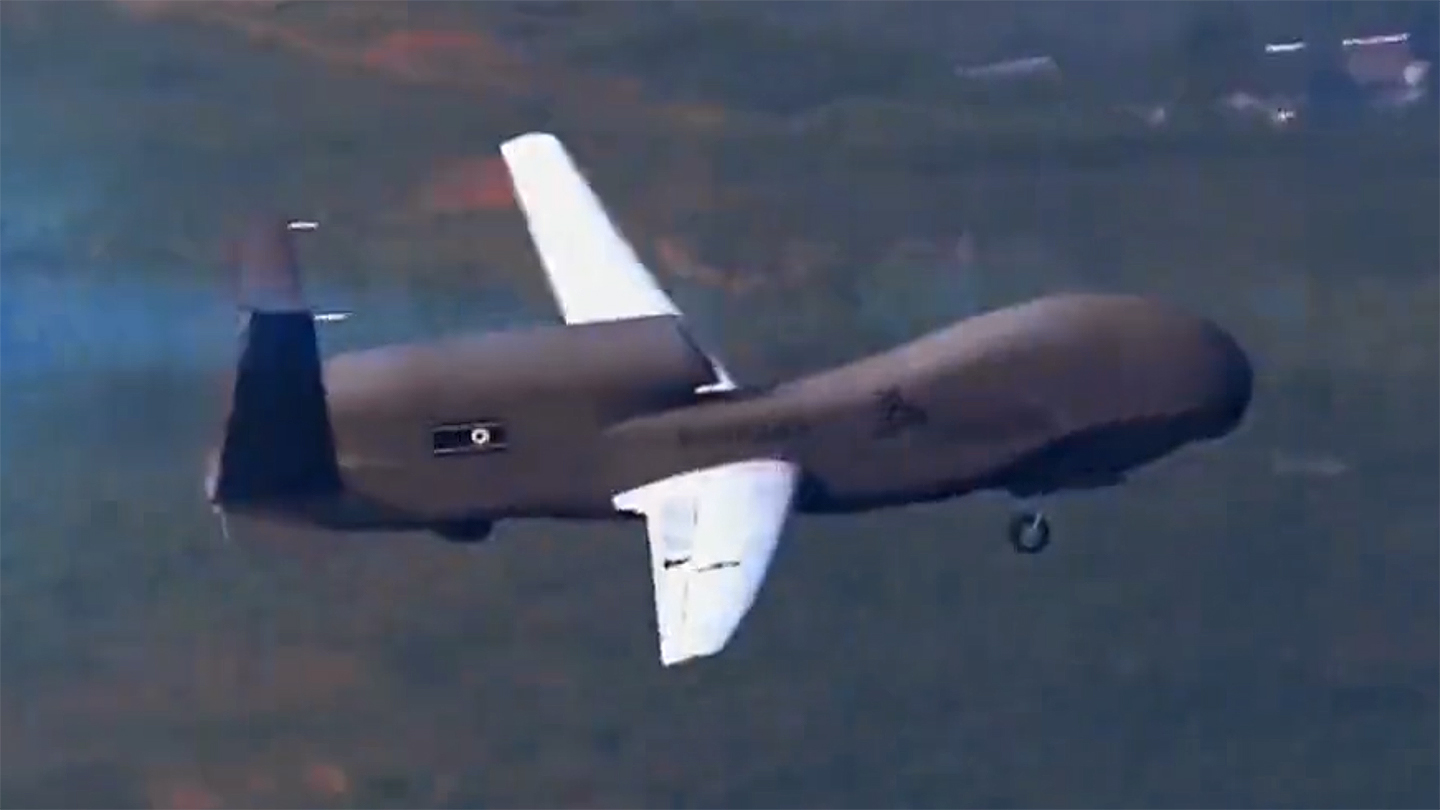North Korea has unveiled two new drones that appear to be almost exact visual copies of the well-known U.S.-made RQ-4 Global Hawk and MQ-9 Reaper unmanned aerial vehicles (UAVs). Its state media has also provided brief videos showing both of them in flight. While the precise capabilities of these North Korean drones remain very much unclear — they are certain to fall well short of their U.S. lookalikes — the fact that Pyongyang has been plowing resources into developing them does at least point to an increasing interest in advanced UAV designs for both surveillance and attack, as well as the ability to actually realize those interests.
The designations of the North Korean drones remain unknown, and, for the meantime, they are being referred to as the “Global Hawk-type” and “Reaper-type.”
Both were formally revealed during the Weapons and Equipment Exhibition 2023 yesterday, attended by North Korean leader Kim Jong Un and Russian Minister of Defense Sergei Shoigu. Shoigu was visiting Pyongyang to further military cooperation between the two countries and, reportedly, to secure more North Korean-made armaments for use in Moscow’s war in Ukraine.
The larger of the two drones, the Global Hawk-type, is very similar in appearance and size to the U.S. Air Force’s jet-powered RQ-4A, as well as derivatives of the same type that are also operated by the U.S. Navy, NATO, and others, including South Korea. Key features of the U.S.-made drone, including the V-tail and the air intake located above the fuselage are faithfully replicated in the North Korean design.
Last month, NK News, a U.S.-based news website covering North Korea, reported that the Global Hawk-type drone had been spotted in satellite imagery while undergoing testing on the ground at Panghyon Air Base, in North Pyongan Province, in the west of the country. Analysis at the time suggested a wingspan of around 115 feet, almost identical to the 116.2 feet wingspan of the RQ-4A. The improved RQ-4B model, by comparison, has a wingspan of 130.9 feet.
As well as the video showing the Global Hawk-type drone apparently during flight testing, a series of photos presented alongside the UAV at the exhibition in Pyongyang show it flying against backdrops in the North Korean capital, including the Ryugyong Hotel and Mirae Scientists Street. It’s unclear if these are genuine photos or if they have been manipulated, adding in the landmarks in the background, for example.
Next to no details are available of the specifications of the Global Hawk-type drone or even the mission that it’s intended to perform. However, its close resemblance to the RQ-4 series clearly suggests a high-altitude flight profile. Depending on engine performance and other factors, it’s likely expected to fly over longer distances. The RQ-4A has an endurance of more than 30 hours and has an intelligence, surveillance, and reconnaissance (ISR) mission, carrying a variety of sensors including imagery intelligence (IMINT), signals intelligence (SIGINT), and moving target indicator (MTI) sensors.


The Reaper-type drone displayed in Pyongyang alongside the larger Global Hawk lookalike also appeared in recent satellite imagery, which indicated a wingspan of around 65 feet. The MQ-9 has a wingspan of 66 feet.
While the turboprop-powered MQ-9 is used for both ISR and attack missions, it’s notable that the North Korean Reaper-type drone was displayed with two different types of missiles carried on six pylons below its wings, including one weapon that looks very similar to the U.S.-made AGM-114 Hellfire. This popular air-to-ground missile is used by the MQ-9, among many others. The brief video clip also shows the drone launching a pair of Hellfire-lookalike missiles, although it isn’t clear if it is real.


The Reaper-type drone was also displayed alongside photos, one of which showed Kim Jong Un looking at the UAV on the runway. It’s possible that this photo was taken during flight testing of the drone, perhaps also at Panghyon.
This drone appeared alongside an apparent specification placard, although the content was blurred by North Korean media.
For some time now, it’s been known that North Korea was developing new drones, although any details of particular designs had been limited until recently.
Nevertheless, at the Party Congress in Pyongyang in January 2021, Kim Jong Un called for the development of “unmanned striking equipment” and “reconnaissance drones,” with a range of 310 miles. It’s not known if the Global Hawk-type and Reaper-type drones were prepared according to this request, but it’s certainly a possibility.

As to the true origins of the two new drones, it may be tempting to see the design parallels as evidence that they are direct attempts to copy the RQ-4 and MQ-9 series UAVs. However, that doesn’t mean that North Korea was able to obtain, by whatever means, plans or other detailed information that would allow them to be reverse-engineered. On the other hand, it’s the case that North Korea has been involved in espionage activities, including targeting Western defense industries, which could potentially yield data that might assist in such an effort. Iran, of which North Korea has an at times troubling relationship with, has also recovered crashed examples of both types and has made their own copies of them. We do not know if these programs are connected to North Korean ones though. Still, having the data does not equate to being able to make a true facsimile of the weapon system in question.
The ability of the country’s industries to actually replicate some of the more complex components and subsystems that lie at the heart of these UAVs’ capabilities is highly dubious. The high-technology sensors that the RQ-4 and MQ-9 series rely on are beyond North Korea’s reach, even with the benefit of espionage. That is not to say that sensors with significantly lower performance aren’t possible. The complex composite structures that make up these aircraft are another issue as is the engine technology. Simpler means of production and engines with less performance could result in significantly lower ceilings and ranges.
It’s also the case that the broad configurations of both the MQ-9 series have been seen replicated, to one degree or another, in other drone designs from different countries.
Also mysterious is the presence of apparent satellite communication (SATCOM) ‘humps’ above the forward fuselages of both North Korean drones. Currently, Pyongyang is not understood to operate the kinds of satellites that could be used to communicate with drones, including ensuring the high bandwidth flow of data between UAV sensors to ground stations beyond line-of-sight.

It remains possible that the SATCOM domes are intended to be used in conjunction with suitable communication satellites from other, friendly countries, although the options here are limited. They are most likely just another form of emulation of the American design, regardless of their utility. They also would keep to the same general moldline in order to leverage a proven design and limit risk. If stolen aerodynamic data is also being relied on, keeping the moldline nearly the same would be a primary goal. Other antenna arrays on the drones are also of questionable value to North Korea.
There is a particular question mark over the engines used in these drones, with limited production capacity in North Korea suggesting that their powerplants would likely have to be secured from foreign countries.
Still, even less-capable drones of this kind could be of use to North Korea.
A Global Hawk-type drone, even with less endurance and ceiling than its U.S. equivalent, and with inferior sensors and data transfer capabilities could still play role monitoring movements on the ground in neighboring South Korea. Depending on its sensor range and operating altitude, such missions could potentially also be flown from relatively deep within North Korean airspace. In a confrontation with the South, the Global Hawk-type drone would not last long in the skies over North Korea, but it could also have a maritime surveillance function during peacetime, which is of increasing importance for Pyongyang as the South continues to expand its naval forces.
North Korea lacks in sensor technology significantly compared to its rivals to the south. Any radar it carries would likely be vulnerable to extensive standoff electronic attacks that could limit its utility even in peacetime. Even using the drone as a communications relay would be a viable mission though, especially for a country that lacks higher-end beyond line-of-sight connectivity.

As for the Reaper-type drone, UAVs of this type have repeatedly shown their value in lower-intensity conflicts around the globe, not only for gathering ISR and distributing it in real-time to ground forces, but also conducting precision strikes using a range of weapons. So far, the North Korean military has lagged behind in terms of drones in this class, especially armed ones.
Late last year, there was a series of incursions into South Korean airspace made by North Korean UAVs, although these were very basic designs, not dissimilar to hobby-type drones. Nevertheless, the fact that one of these drones managed to enter a no-fly zone around the office of the South Korean president provided an indication of the kind of threat that UAVs can pose and prompted an urgent overhaul of South Korean defenses against these kinds of threats.
In the past, North Korea has otherwise mainly used small and crude reconnaissance drones, but it is known to have larger types, including those that are similar to target drones, like the ones shown below while on parade in Pyongyang.

In addition, there have been indications that the regime has worked to clone Chinese designs and generally improve in this area in recent years. This includes developing more capable ‘man-in-the-loop’ types and those that are based on commercial developments. It’s possible that China, with a considerable amount of experience in the field, might also have provided assistance to North Korea as it developed these two new drone designs.
While neither of these types would be survivable in an all-out conflict with South Korea and the United States, just building, testing and operating them could be seen as a useful endeavor for North Korea. The experience gained here could allow their largely independent aerospace industry to achieve other designs that are more tailored to the tactical realities they face. And, as we noted, they could provide some relevant use during peacetime. The reality is that just getting them flying at all is an accomplishment.

There are rumors already that examples of the new drones could make an appearance at a military parade that’s expected to take place in North Korea next week. Of most interest will be the possible proliferation of long-range loitering munitions in North Korea, like Iran’s Shahed-136 that is wreaking havoc in Ukraine. These weapons are far more relevant to Pyongyang and they could be built in very large numbers, offering a massive problem to South Korean air defenses.
Moreover, it’s likely we will only see more of these, and probably other drone designs, too, as Pyongyang increasingly shows interest in the potential of UAVs as part of its wide-ranging effort to modernize its military.
Update, July 28: Examples of both the “Global Hawk-type” and “Reaper-type” drones performed flyovers of Pyongyang last night, as part of the country’s latest military parade, commemorating the 70th anniversary of the end of the Korean War.
On the ground, the parade also included at least three examples of the MQ-9 clone, carried on flatbed trucks. The three weapons pylons under each wing were armed with eight of the Hellfire-lookalike missiles, as well as two other munitions, broadly similar in appearance to the U.S.-made Small Diameter Bomb (SDB), apparently with pop-out wings.


Meanwhile, the official designations of the two drones have also been released. These are the Morning Star-4 (샛별-4, or Saetbyol-4 in Korean) for the Global Hawk-type and Morning Star-9 (샛별-9, or Saetbyol-9) for the Reaper-type. Notably, the designations follow the same numerical format as the U.S. drones that the copy, the RQ-4 and MQ-9, respectively.
Contact the author: thomas@thedrive.com
